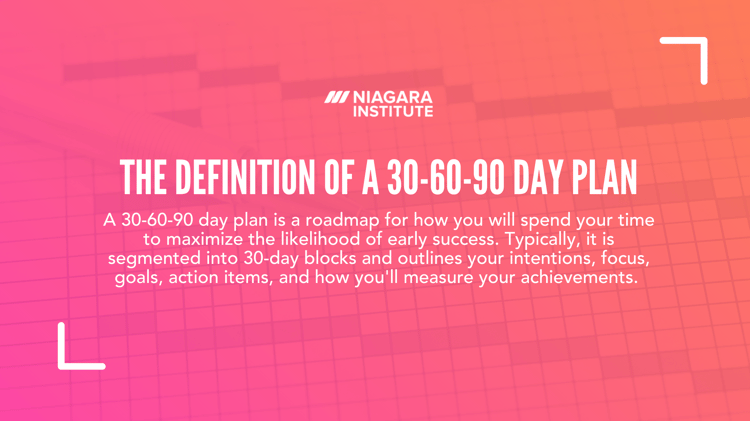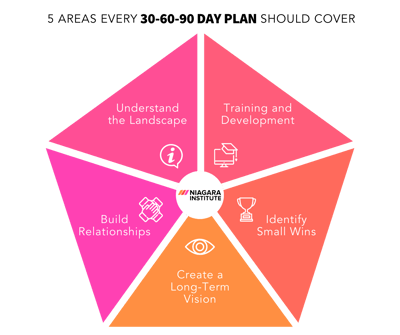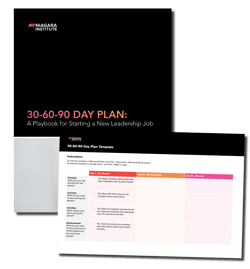30-60-90 Day Plan:
A Playbook for Starting a New Leadership Job
Starting a new leadership job is both exciting and stressful. Fortunately, you can ease the transition and maximize your chances of success by creating a 30-60-90 day plan. In the following playbook, you'll learn more about the process of doing so, as well as find a fully editable 30-60-90 day plan template.
Download the PDF (English & French Included)
Introduction
There is a seismic shift happening within the workplace right now called “the great resignation.” While the cause of this is cited as COVID-19, the reality is that the velocity of job change increased even before 2020.
Today, individuals transition into new jobs every four years, with 12 career transitions throughout their lifetime. Even those not currently transitioning to a new job may be actively thinking about doing so. According to a study by Prudential, 1 in 4 employees is preparing for a new opportunity outside their current organization once the pandemic has subsided. Moreover, 40% of respondents to a Microsoft Workplace Trends study said they plan to leave their employer in 2021.
So, why do we see such changes? A large part of what is currently happening is due to a lack of opportunities. Among those planning on changing their roles post-COVID, 80% said they're doing so because they're concerned about career advancement. This feeling is quantified by a study conducted by Robert Half, where 27% of respondents agreed that they feel stuck in their careers due to the pandemic.
Job transitions are happening not just among individual contributors but also among leaders. In a McKinsey survey, 67% of respondents said their organizations now experience "some or many more" leadership transitions than they did in previous years. With all this movement, it is arguably more important than ever for those starting new leadership roles to prioritize creating a plan that eliminates undue stress and maximizes the likelihood of a smooth transition for all. If you do so effectively, there is a 90% likelihood that your team will meet their three-year goals, and the attrition rate among employees will be 13% lower.
With the help of the following playbook, you will not only be inspired but prepared to create a 30-60-90 day plan of your very own. We’ll cover what a 30-60-90 day plan is, why it’s important, the five areas your plan should cover, and the common pitfalls leaders make when creating one. Finally, we’ll leave you with an editable 30-60-90 day plan template that will make getting started and putting all that knowledge to use that much easier. Let’s begin.
What Is a 30-60-90 Day Plan?
During your first 90 days in a new leadership role, it can be challenging for even the most seasoned leaders to decide which actions will have the most significant impact. That’s where a 30-60-90-day plan comes in. In the simplest terms, a 30-60-90 day plan is a roadmap for how you will spend your time to maximize the likelihood of early success. Typically, it is segmented into 30-day blocks and outlines your intentions, focus, goals, action items, and how you'll measure your achievements.

Why Is It Important to Have a 30-60-90 Plan?
Starting a new leadership job, whether it is in your current organization or at a new one, is exciting and stressful all at the same time. Creating a 30-60-90 day plan solidifies the direction you will take and what has to get done to ease the transition.
To hit the ground running, you need clarity on where you're going and your plans, and the sequential actions you'll take to get there. The time invested upfront in creating a 30-60-90 day plan allows you to move faster as you execute it. Your plan acts as your blueprint for your first three months in your new role. It also does the following:
- It pushes you to intentionally determine your goals, where you will focus your time, and think through all the actions and activities in the first three months.
- It gives you documentation to follow and a clear direction.
- It helps you align with your leader(s) and manage expectations around what is possible in the first 90 days.
- It eliminates distractions as many individuals will be vying for your attention.
- It creates a sense of accountability to the timeline and goals you have set and agreed to meet.
5 Areas Every 30-60-90 Day Plan Should Cover
 When starting any new leadership role, the goal is to get up to speed as quickly as possible so that you can begin wielding your expertise, making progress, and showing your actual value. While your organization or department will more than likely have an onboarding process, you will probably need to fill in the remaining gaps by seeking out information, setting up meetings, and asking questions of your own. Those additional activities are what should be central to your 30-60-90 day plan.
When starting any new leadership role, the goal is to get up to speed as quickly as possible so that you can begin wielding your expertise, making progress, and showing your actual value. While your organization or department will more than likely have an onboarding process, you will probably need to fill in the remaining gaps by seeking out information, setting up meetings, and asking questions of your own. Those additional activities are what should be central to your 30-60-90 day plan.
Here are five areas that a well-thought-out 30-60-90 day plan will cover:
Understand the Landscape
During your first 90 days, you'll want to talk to as many people as possible to get a thorough understanding of the organization and build rapport with your new colleagues. At this point, it’s all about creating a solid foundation of knowledge that will help you make informed decisions when the time comes. Therefore, your priority should be spending time with your boss, direct reports, and colleagues with whom you'll be working closely.
During your time with these people, ask them probing questions to get a clear sense of the organization, the opportunities, and the challenges at hand. Here is an extensive list of questions new leaders should ask during those first 90 days on the job:
Industry and the Competitive Landscape
- Who are the direct and indirect competitors?
- Are there any threats or new entrants to the industry?
- Are there any opportunities that the organization should be pursuing but isn’t? Why do you think that is?
Company Mission, Vision, and Values
- What is the company mission?
- What is the vision for the company?
- What are the corporate values?
Company Goals and Objectives
- How has the organization performed? Have goals been achieved? Why or why not?
- What are the short and long-term goals and the plans to make them a reality?
- Are there any ongoing or upcoming organizational initiatives to be aware of?
Company Culture, Norms, and Behaviors
- What do people love about the organization?
- How do individuals, teams, and departments interact with each other?
Company Policies
- What are the company policies?
- Where can they be found?
- What is the process if a policy is not followed by one of my employees?
Customers and Value Proposition
- Who are our customers?
- Who are our top clients?
- What do they value?
- Why did they choose our company?
- What makes our product or service unique?
- What is the biggest customer complaint?
Product Lines and Profitability
- What products/services does our company sell?
- Is there a product or service that is more profitable or important to the organization? Why?
Departments, Systems, and Processes Across the Company
- What processes do I need to know?
- Are processes recorded, easily accessible, and regularly updated? If so, where can they be found?
- Where do handoffs take place across the organization?
- What systems do I need to learn?
Stakeholders, Decision-makers, and Influencers
- Who has influence?
- Who makes decisions?
- How are purchases made?
Your Department and Team
- What is the team/department objective?
- What have been the results over the last couple of years?
- What role does everyone play in the team and department?
- How does work get allocated? What is everyone’s capacity and workload?
- What do we do well?
- What do we need to change to improve our results?
- What is the tech stack and software we use?
- What is our process for getting work done? Where do handoffs take place?
- What projects are underway?
- Are there any new initiatives that will start in the next couple of months?
- Are there mistakes that repeatedly happen?
Team Members
- How do you impact the team?
- What are your accountabilities?
- What do you enjoy about your role?
- What type of work do you enjoy that makes you lose track of time?
- Where do you struggle?
- What would you change about your job? About the team?
- What would make your job more enjoyable?
- Are you challenged in your current job?

Training and Development
Your 30-60-90 day plan should include any training and development you'll need to succeed in your new role. Use the first 90 days to identify your needs, seek out providers, secure budget and buy-in, and then set a timeline to make it a reality. The training you will want to receive includes but is not limited to the following:
- Leadership training
- Business management and financial training programs
- Function-related skills development
- Training on specific software and systems
- Internal training programs such as the company’s diversity, equity, and inclusion or safety training program
- Working one-one with a leadership coach
Build Relationships
When you prioritize building relationships during your transition to a new leadership role, you establish a network of colleagues who can be your sounding board, help you achieve your goals, provide support, and offer unique perspectives. Moreover, Quantum Workplace notes that building relationships in the workplace contributes to higher engagement, lower stress, increased satisfaction, and quicker resolution of conflicts.
Therefore, in your 30-60-90 day plan, make it a priority to meet with those you will be working the closest with. During that time, ask them questions about the business to help you gain perspective and about them personally, such as their passions, family, and what they enjoy doing outside of work. To help ensure you make the most of the time spent with your colleagues and get your relationships off to a good start, here are some examples of general business questions you may ask:
- What are their expectations of you?
- What are their most important priorities right now?
- If you could wave your magic wand, what would be the one thing you wish I could fix?
- What could we improve?
- What is working well?
- Are there ways we can better leverage each other's expertise?
- What do you love about your department, team, and company?
- How do you collaborate and stay aligned with others?
Small Wins
When a new leader enters the picture, everyone is eager for real change to start happening. Though in reality, it can take long past your first 90 days for this to be possible.
Fortunately, there are usually small, maybe annoying, processes that you, as the leader, can quickly fix for your team. These are called small wins, and according to one TED Talk speaker, “Small wins have transformational power. Once the first small win is achieved, forces are set in motion to favor another small win and another small win until the combination of these small wins leads to larger and greater accomplishments.”
Therefore, one component of your 30-60-90 day plan should identify things that can be easily fixed and celebrated. To do so, make a list of the common complaints you've heard through all your conversations and work with your leader to determine which fix would have the most significant impact and can easily be implemented.
Long-Term Vision and Planning
When you feel you have a solid foundation of knowledge regarding your role, team, and organization, it’s time to explore the more significant issues you've heard about, gather facts, and determine if what you've heard is fact or fiction.
Analyzing the information you've collected will be the foundation to develop a roadmap of where you'll focus your efforts going forward. As you meet with individuals over the first three months, jot down your ideas based on the suggestions below. You should have a long list of ideas to formulate a formal long-term vision and plan by the end of the first three months.
- Conduct a SWOT (Strengths, Weakness, Opportunities, and Threats) analysis. This analysis will help you determine what should remain the same, what the team needs to do more of, what needs to change, and what needs to stop altogether.
- Begin to craft a vision for your team. Think through what the team aims to do, why it is worth pursuing, and the impact achievement will have on the team and the organization.
- Formulate your ideas regarding the ideal team culture, values, and goals, and get input from your team by conducting a collaborative session using the Team Alignment Worksheet.
- Determine how you will measure success by establishing SMART goals for your team.
- Once you have a clear idea of your vision and goals, map out any needed resources to start the approval process. At this point, you must be just as clear about what you will do as what you won't do. Next, determine the best place to focus and spend your time to make the most significant impact.
.png?width=1920&name=Creating%20a%20Long-Term%20Plan%20During%20the%20First%203%20Months%20in%20New%20Leadership%20Role%20(1).png)
Get Your PDF
Save This For Later
After filling out the form, we will send you to the PDF version and also a copy to your email so you can file it away or share it with your colleagues.
5 Pitfalls to Avoid in Your First 90 Days
No doubt you'll want to make a great impression and the first 90 days are crucial as this is when perceptions develop about you and the type of leader you'll be. It's just as important to know what not to do as it is what to do. Here are common traps new leaders should avoid.
1. Not Listening Enough or To a Variety of People and Perspectives
You want to be a sponge in your first months on the job, which requires active listening. Therefore, you’ll want to hear from various people as they will all have a unique perspective that will help inform your opinions.
2. Criticizing the Previous Leader and Team
Your boss, team, and new colleagues were part of the previous regime, so coming in with a critical attitude and comments will not be helpful. Instead, recognize the great work the team has completed and the solid foundation they had started.
3. Thinking You Have All the Answers Because You've Done It Before
When starting a new leadership job, you'll come with ideas that have worked for you in your previous roles. However, it is dangerous to assume what your team and department need based on your previous experience. You will want to wait until you have met with various people to decide what is required and set the strategy.
4. Coming In as the Boss
Your attitude should be approachable and open to learning, not direct, in your first 90 days in a new leadership role. It’s best to come right out and say, "I'm here to learn from you." Doing so will ease the anxiety that others may have that you are unapproachable to share their opinions and ideas.
5. Believing You Will Have It All Figured Out in 90 Days
If you think you will have a crystal clear picture with no self-doubt in your strategy by the end of your first three months, you're setting yourself up for disappointment. Give yourself grace; it will take time to formulate your vision, goals, and strategy fully. One of the worst things you can do is rushing to create your long-term plan without allowing yourself the time to learn, conduct a thoughtful analysis, and set a strategy.
How To Structure a 30-60-90 Day Plan
Day 1 - 30: Observe
During the first 30 days in a new leadership role, your objective is to observe and orient yourself, not suggest and change. While you’ll be eager to get started, it’s important to remember that there will be plenty of time for that in the coming months and that doing so without the proper understanding can do more harm than good. So, be patient, ask lots of questions, manage your own biases or judgments, and be prepared to be uncomfortable and humbled in the face of all that you don’t know.
Here are some examples of tasks and goals that would likely appear in the first 30 days of your 30-60-90 day plan when starting a new leadership job:
- Decide the cadence of one-on-one meetings with your leader and schedule them
- Decide the timing of one-on-one meetings with your direct reports and schedule them
- Schedule and host your first team meeting
- Review and complete all onboarding training and paperwork
- Meet with HR to discuss the company culture and values
- Read all documents (if none exist, have a meeting) about the team’s processes and procedures
- Review your employee’s goals and performance reviews
- Attend company-provided training and identify the need for additional training or coaching
Day 31 - 60: Contribute
In the following 30 days, your objective should shift from observing to contributing. During days 31 to 60, you should start to embed yourself in different business areas to gain further knowledge, test assumptions, and fill any gaps in your knowledge. Some examples include going on a sales call to understand the customer better, meeting with the operations team to understand internal processes, or shadowing one of your direct reports. In other words, you begin to do the work but are still very much in learning mode.
Here are some examples of tasks and goals that would likely appear in the second portion of your 30-60-90 day plan:
- Shadow each of your direct reports to not only understand their job but their approach, personality types, and preferences as well
- Meet with department heads/team leaders
- Conduct a SWOT (Strengths, Weakness, Opportunities, and Threats) analysis for your team
- Meet with the finance team to review the team’s budget and ask questions
- Formulate SMART goals for yourself and the team
- Identify any tools and processes that are ineffective and formulate a plan for eliminating/replacing them
- Secure budget for leadership, business management, or financial acumen training, or coaching services
Day 61 - 90: Lead
In the third month of a new leadership role, you can begin to transition from learner to leader. At this time, you should formalize your ideas based on the understanding and knowledge you gathered in the 60 days. You will either turn those ideas into a strategy and action plan or identify a gap in information that needs to be filled before action can be taken.
Here are some examples of tasks and goals that are best suited for the final portion of a 30-60-90 day plan:
- Host a meeting to review, revise, and get aligned on the team’s goals
- Identify small wins and tackle them
- Compile your findings, assumptions, and plans with your leader
- Enroll in training or book coaching
- Begin to formalize your team’s long-term vision and goals
- Analyze the current team culture, define the desired team culture, and secure buy-in from your leader and team
.png?width=1920&name=How%20To%20Structure%20a%2030-60-90%20Day%20Plan%20(1).png)
Next Steps
The goal of your 30-60-90 day plan is to solidify the actions you will take in your new leadership role and the accomplishments needed to ensure a smooth transition for all. You can support such a goal by honing your leadership skills and learning new tools with the help of training and coaching.
Fortunately, the Niagara Institute has spent the past 50 years providing exactly that and supporting leaders at all levels successfully transition into new roles. Between our open-enrollment training programs and extensive roster of professional one-to-one coaches, you’ll find the support you need to embark on the next phase of your career confidently.
Get Your PDF
Save This For Later
After filling out the form, we will send you to the PDF version and also a copy to your email so you can file it away or share it with your colleagues.


